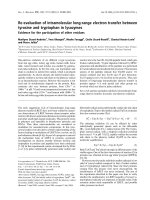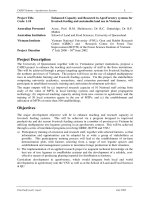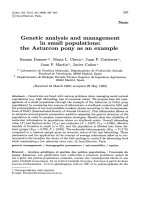analysis and recommendations in strategic adjustment for vndirect securities jont stock company
Bạn đang xem bản rút gọn của tài liệu. Xem và tải ngay bản đầy đủ của tài liệu tại đây (1.13 MB, 151 trang )
VIETNAM NATIONAL UNIVERSITY, HANOI
SCHOOL OF BUSINESS
NGUYEN THI PHUONG THAO
ANALYSIS AND RECOMMENDATIONS IN STRATEGIC
ADJUSTMENT FOR VNDIRECT SECURITIES JOINT
STOCK COMPANY (2011 – 2016)
MASTER OF BUSINESS ADMINISTRATION THESIS
Hanoi - December 2010
2010 * Master of Business Administration Thesis * Nguyen Thi Phuong Thao
VIETNAM NATIONAL UNIVERSITY, HANOI
SCHOOL OF BUSINESS
NGUYEN THI PHUONG THAO
ANALYSIS AND RECOMMENDATIONS IN STRATEGIC
ADJUSTMENT FOR VNDIRECT SECURITIES JOINT
STOCK COMPANY (2011 – 2016)
Major: Business Administration
Code: 60 34 05
MASTER OF BUSINESS ADMINISTRATION OF THESIS
Supervisor: Dr. Nguyen Viet Anh
Hanoi - December 2010
viii
TABLE OF CONTENT
ACKNOWLEDGEMENTS i
ABSTRACT ii
TÓM TẮT v
TABLE OF CONTENT viii
LIST OF TABLES xi
LIST OF FIGURES xii
LIST OF ABBREVIATIONS xiii
INTRODUCTION 1
1. Necessity of the thesis 1
2. Objective of the thesis 3
3. Research questions 3
4. Scope of work 3
5. Methodology 4
6. Contributions of the thesis 5
7. Expected results 5
8. Further research directions 5
9. Limitation of the thesis 6
10. Thesis structure 6
CHAPTER 1: LITERATURE REVIEW 7
1.1. Strategy and role of strategy 7
1.1.1. Definition of strategy 7
1.1.2. Role of strategy 9
1.2. Strategic management process 9
1.3. Strategic vision and business mission 12
1.4. Setting objectives 12
ix
1.5. External environment analysis 13
1.5.1. Macro environment analysis 14
1.5.2. Industry and competition environment analysis 17
1.6. Company situation analysis 26
1.6.1. Analysis of how well the current strategy works 26
1.6.2. Analysis of company’s roots of competitive advantage 27
1.6.3. Analysis of company‘s cost structure 30
1.6.4. Evaluate the company‘s competitive position 33
1.7. SWOT analysis 35
1.7.1. What is SWOT? 35
1.7.2. SWOT matrix 36
1.8. Formulating a strategy 36
1.8.1. Levels of strategy - The Strategy making pyramid 36
1.8.2. Specific strategy at different levels 37
CHAPTER 2: CASE STUDY OF VNDIRECT 45
2.1. Over all about VNDIRECT 45
2.1.1. General information about VNDIRECT 45
2.1.2. The establishment and development of the company 46
2.1.3. The company organizational structure 47
2.2. Analysis of strategic vision and business mission 48
2.2.1. Analysis of current strategic vision of VNDIRECT 48
2.2.2. Analysis of current business mission of VNDIRECT 49
2.3. Objectives of VNDIRECT 50
2.4. External environment analysis 50
2.4.1. Macro environment analysis 50
2.4.2. Industry and competition environment analysis 58
2.5. Situation analysis of VNDIRECT 80
2.5.1. Analysis of how well the corporate strategy works 80
2.5.2. Analysis of how well the business strategy works 82
x
2.5.3. Analysis of how well the functional strategy works 89
2.5.4. Analysis of business result of the company 106
2.5.5. Analysis of company’s resources and capabilities 108
2.5.6. The value chain and the company ‘s cost structure 111
2.5.7. Evaluate the company ‘s competitive position 113
CHAPTER 3: SUMMARY AND RECOMMENDATIONS 116
3.1. Summary and recommendations for theory development 116
3.2. Summary and recommendations for Government bodies 117
3.3. Findings for VNDIRECT 119
3.3.1. SWOT matrix analysis of VNDIRECT 119
3.3.2. Distinct competencies of VNDIRECT 122
3.4. Recommendations for VNDIRECT company from 2011 – 2016 122
3.4.1. Recommendations in strategic vision and business mission adjustment
122
3.4.2. Recommendations for corporate strategy adjustments 123
3.4.3. Recommendations for business strategy adjustments 125
3.4.4. Recommendations for functional strategy adjustments 129
3.4.5. Summary of strategic development direction of VNDIRECT 133
CONCLUSION 135
REFERENCES 137
APPENDICES 140
xi
LIST OF TABLES
TABLE 1-1: A MODEL OF WEIGHTED COMPETITIVE STRENGTH ASSESSMENT 34
TABLE 1-2: MODEL OF SWOT MATRIX 36
TABLE 2-1: GENERAL INFORMATION ABOUT VNDIRECT 45
TABLE 2-2: PREDICTION OF GDP OF VIETNAM IN 2010 51
TABLE 2-3: THE DEVELOPMENT OF SECURITIES INDUSTRY VIA SOME CATEGORIES . 58
TABLE 2-4: MINIMUM REQUIRED CAPITAL FOR SECURITIES OPERATIONS 61
TABLE 2-5: AVERAGE PROFITABILITY INDEX OF SOME MAJOR INDUSTRIES IN 2009 63
TABLE 2-6: DOMINANT ECONOMIC FEATURES OF THE SECURITIES INDUSTRY 63
TABLE 2-7: TOP 20 COMPANIES IN TERM OF CHARTER CAPITAL 69
TABLE 2-8: TOP 10 LEADING COMPANIES IN REVENUES IN EACH ACTIVITY IN 2009. 70
TABLE 2-9: REVENUE STRUCTURE IN 2009 OF MAJOR COMPANIES IN GROUP 3 74
TABLE 2-10: A SUMMARY OF MAIN RIVALS ‘S CHARACTERISTICS AND MOVES 76
TABLE 2-11: TOTAL SALARY AND BENEFIT FOR BOARD OF MANAGEMENT OF
VNDIRECT IN 2009 102
TABLE 2-12: EMPLOYEES ‘S QUALIFICATION OF VNDIRECT 103
TABLE 2-13: CAPITAL INCREASING PROCESS OF VNDIRECT 104
TABLE 2-14: SEVERAL CATEGORIES OF BUSINESS RESULT OF VNDIRECT (2007-
2009) 107
TABLE 2-15: BUSINESS UNIT COST STRUCTURE ANALYSIS AMONG VNDIRECT AND
RIVALS IN 2009 112
TABLE 2-16: A MODEL OF WEIGHTED COMPETITIVE STRENGTH ASSESSMENT OF
VNDIRECT, SSI AND TLS 114
TABLE 3-1: SWOT MATRIX ANALYSIS OF VNDIRECT 119
TABLE 3-2: RECOMMENDED DEVELOPMENT ROAD MAP OF VNDIRECT FROM 2011-
2016: 133
xii
LIST OF FIGURES
FIGURE 1-1: STRATEGIC MANAGEMENT MODEL 9
FIGURE 1-2: EXTERNAL ENVIRONMENT 13
FIGURE 1-3: 5 FORCES COMPETITION MODEL 18
FIGURE 1-4: THE GENERIC BUILDING BLOCKS OF COMPETITIVE ADVANTAGE 27
FIGURE 1-5: A REPRESENTATIVE VALUE CHAIN MODEL 31
FIGURE 1-6:THE STRATEGIC MAKING PYRAMID MODEL IN A DIVERSIFIED COMPANY
37
FIGURE 1-7: MODEL OF BUSINESS STRATEGIES 40
FIGURE 2-1: ORGANIZATIONAL STRUCTURE OF VNDIRECT 47
FIGURE 2-2: INTERNET USERS GROWTH 2000-2009 IN SELECTED ASIAN COUNTRIES
57
FIGURE 2-3: INTERNET USERS IN VIETNAM 2005-2009 57
FIGURE 2-4: THE VALUE CHAIN OF VNDIRECT 111
xiii
LIST OF ABBREVIATIONS
GDP : Growth Domestics Product
VNDIRECT : VNDIRECT Securities Joint Stock Company
HSX : Ho Chi Minh City Securities Exchange
HNX : Hanoi Securities Exchange
IPO : Initial Product Offering
ROA : Return on Asset
ROE : Return on Equity
KSF : Key Success Factor
OTC : Over the counter
SSC : State Securities Commission
VNNIC : Vietnamese Internet Center
ABS : An Binh Securities joint stock company
ACBS : ACB securities company Ltd.
AGRISECO : Agribank securities joint-stock corporation.
BSC : BIDV securities company Ltd.
BVSC : Baoviet securities joint stock company
DAS : Dong A securities company Ltd.
FPTS : FPT securities joint stock company
HBBS : Habubank securities company Ltd.
HBS : Hoa Binh securities joint stock company
HSC : Hochiminh city securities corporation
KLS : Kim Long securities corporation
SBS : Sacombank securities joint stock company
SHS : Saigon Hanoi securities joint stock company
SSI : Saigon securities incorporation
TLS : Thang Long securities joint stock company
VCBS : Vietcombank securities company Ltd.
xiv
VIETINBANKSC
: Vietnam Bank for Industry and Trade securities Joint
stock company
1
INTRODUCTION
This part will give an introduction to readers about the thesis. Firstly, the
necessity of the thesis is mentioned, next are objectives of the thesis, then researches
questions are raised up, followed by scope of work, methodology, thesis ‘s
contributions, expected results, further research directions and. limitations of the
thesis. Finally, the thesis structure is presented in order to help readers have an
over-all picture of the whole study.
1. Necessity of the thesis
The Vietnamese securities market was established in 2000 at a very small
initial scale. In the first 5 years, the market developed slowly with low market
capitalization and low number of listed stocks, which leads to the small number of
securities companies and the slow activity of these companies. Since 2006, with the
stronger implementation of State owned enterprises, the supply of stock in the
market is bigger, which creates a motivation for the development of the market in
term of both market volume, demand and growth rate and therefore, helps the
market to become one of the most interested industry by the whole society. The
total number of securities companies, therefore, has also increased accordingly in
the peak period of the market in 2007. However, in 2008, due to the world crisis,
the Vietnamese securities market had been continually slowed down and reached
the bottom at the beginning of 2009, which created main difficulties for companies
within the industry. Although after that, the market had a sign to recover in 2009,
but the recovery trend was not quite clear and at present, the market is still in
fluctuation period. In the hard time of the economy with a decrease of the demand,
securities companies have to cope with many difficulties relating to the existence,
such as big loss in investment and dealing activities, high overhead and personnel
costs, low brokerage revenue, and the severe price war in cutting down brokerage
fees. Moreover, the threats of foreign rivals also exist. This leads to hidden risks for
2
securities companies in coping with severe competition pressure to find out an
effective strategy to sustainable exist and develop in the market.
Established in 2006 with a very small initial investment capital, only 50
billions dong, VNDIRECT securities joint stock Company has also passed nearly all
periods (developing and recession) of the market. VNDIRECT had a comparatively
effective strategy in the starting period aiming at online customers and focus on
technology development and gained a comparative high earning and return on
equity (earning after tax in 2007 was nearly billions dong, ROE was 21.5%). The
economic crisis and the recession of the stock market has put VNDIRECT to cope
with very difficult strategic issues, which are a big loss of more than 86 billions
dong in 2008, low trading value and the serious lack of operating capital. Before
these big pressures, the board of management had comparatively relevant steps
which are restructuring to cut cost, separate the brokerage activity and dealing
activity, implementing to be listed to increase capital. These steps helped to recover
the activities of the company and regain the belief of investors, which create a base
for the following developing periods. However, before the severe and changing
business environment like today, it is required that the company must have some
certain adjustment in the strategy which is more effective to take advantage of all
resources and capabilities of the company, to create a sustainable competitive to
cope with opportunities and threats of the market.
With the research and analysis of the macro environment, the securities
industry and securities companies, as well as the situation of VNDIRECT
Company, this thesis has shown out a necessity in strategic adjustments to
effectively compete in the market.
The purpose of this thesis was to analyze the macro environment, analyze the
security industry and competitive pressure among securities companies, analyze the
specific situation of VNDIRECT Company, and from the above analyses, giving out
several recommendations in strategic adjustment for VNDIRECT in the upcoming
time 2011-2016 to enhance the competitiveness in the market.
3
2. Objective of the thesis
The objectives of this thesis focus on:
Review the theory in strategy and strategic management
Analyze the Vietnamese securities industry and competitive pressure among
securities companies in Vietnam.
Analyze the specific situation of VNDIRECT company
Give out several recommendations in strategic adjustment for VNDIRECT in
the upcoming time 2011-2016 to enhance the competitiveness in the market
3. Research questions
The research‘s author seeks answers for the following questions:
What is strategy and what is the role of strategy?
What are major steps in a strategic management process in formulating a
strategy?
How does the external environment (including macro and the industry) affect to
the activity of VNDIRECT?
How well does the current strategy of VNDIRECT work? (Corporate strategy,
business strategies, functional strategy)? What are roots of competitive
advantage of VNDIRECT? What is the competitive position of VNDIRECT?
What is needed to be developed in the theory for strategic management in
finance and securities industry?
What are suggested for Government bodies to stimulate the Vietnamese
securities market?
How does the strategy of VNDIRECT should be adjusted in order to be
competitive in the market within the next few years?
4. Scope of work
The research areas are limited to analysis and adjust a strategy for a specific
securities company (VNDIRECT). To do this, macro environment and securities
4
industry environment are included in the research. The period of time for past
analysis in securities industry environment is from 2000-2010. It is taken since the
time of establishing the securities market in Vietnam. For the analysis of
VNDIRECT, the period of time for past analysis is from 2007, as VNDIRECT was
established in late 2006.
The time for future strategy is from 2011-2016. This is partly because of the
fast development of the industry; it should take short-term to mid-term time to
review this strategy.
5. Methodology
5.1 Research method
Qualitative methods: Qualitative methods were used when reviewing the
theory and the general remarks of the fact as results of direct interview or
observation/collecting data from secondary resources. The typical used method is
expert interview, which helps a lot in analysis in Chapter 2 (industry and company
situation analysis).
Quantitative methods: Quantitative methods (together with statistic data) were
used widely in some parts like comparison on some specific figures (market share,
revenue growth development, etc).
5.2 Data collection
Data was collected from 2 sources:
Primary sources: Part of the facts on the thesis is collected by observation and
direct interview (with several old and current managers and employees of
VNDIRECT, strategic experts in securities industry and official publication like
annual reports and prospectus of VNDIRECT and other securities companies).
Secondary sources: In some part (especially in Chapter 1 – Literature review),
data was collected from secondary sources like textbooks, previous publishing,
official information in internet and in electronics newspapers, and some industry
reports of several investment funds and securities companies.
5
6. Contributions of the thesis
The thesis contributes to:
Approach systematically strategic theory applying in securities industry.
Give out an overall analysis in macro environment and in securities industry,
especially the key success factors, drivers of changes, 5 forces model analysis.
Study the case of a specific securities company (VNDIRECT).
Recommend in strategic adjustments for VNDIRECT Securities Company. This
can also be a reference source for other securities companies.
7. Expected results
Expected results of the study are:
Giving out a whole picture of the securities industry: macro environment,
dominant economics features and industry environment.
Giving out a deep analysis about the current situation of VNDIRECT securities
company: How well the current strategies work, the company‘s roots of
competitive advantage and its competitive position.
Giving out recommendations for theory development, for Government bodies.
Suggesting strategic adjustment for VNDIRECT to be more competitive in the
market.
8. Further research directions
Further research directions might be:
Research and suggest solutions to develop the Vietnamese securities market in a
specific time schedule (5 or 10 years).
Research the strategic management model of other securities companies (which
might be in the same or different strategic group of VNDIRECT).
Deeper research on dominant economics features, including key success factors
in the securities industry.
6
Research model of establishment and development of foreign securities
companies (or securities market) to draw out practice lessons for applying in
Vietnamese securities companies/securities market.
9. Limitation of the thesis
The thesis has some certain limitations:
The interview for securities experts is conducted qualitatively but not
quantitatively. The result will be more reliable if a survey is conducted
quantitatively (in a large sample survey) and analyzed under a form of statistic
model.
The cost structure analysis based on the value chain among VNDIRECT vs.
rivals is not completed because of the lack of detailed financial figures.
The competition analysis among rivals within the industry only covers 2 biggest
rivals but does not cover all major ones.
10. Thesis structure
Besides the introduction, conclusions and additional parts (references and
appendices), the thesis is divided into 3 major chapters as follows:
Introduction
Chapter 1: Literature review
Chapter 2: Case study of VNDIRECT
Chapter 3: Summarize and recommendations
Conclusion
References
Appendices: Interview content
7
CHAPTER 1: LITERATURE REVIEW
Literature review is an important part of any thesis as if helps to remind
readers about previous theories relating to the topic discussed. In this chapter, the
theory in strategy and strategic management will be reviewed as a based for
analyses in following chapter.
1.1. Strategy and role of strategy
1.1.1. Definition of strategy
Strategy is a broad term which covers all of the activities of a company. In the
theoretical base, there are various definitions about strategy.
Professor Arthur Thompson and Strickland, in their book Strategic
Management
1
defined “strategy” as a “game plan” management has for positioning
the company in its chosen market arena, competing successfully, satisfying
customers, and achieving good business performance. In this definition, the term of
“positioning” is emphasized, as Thompson saw the importance of identifying
clearly the positioning of the company in the market.
Dr. Erica Olsen, in her book “Strategic Planning for Dummies”, has given
another definition: “Strategy means consciously choosing to be clear about your
company’s direction in relation to what’s happening in the dynamic environment.
With this knowledge, you’re in a much better position to respond proactively to the
changing environment”.
Professor Michael L.Porter of Harvard University, USA, has stated his own
viewpoints in the article “What is strategy?” in Harvard Business Review. In his
opinion, strategy is performing different activities from rivals’ or performing similar
activities in different ways. It is the creation of a unique and valuable position,
involving a different set of activities. Strategy, therefore, is quite different from
“Operational Effectiveness (OE) which is only “Performing similar activities better
1
Arthur Thompson and Stricklands, Strategic Management: Concepts and Cases,10th edition, McGraw Hill
8
than rivals perform them”. Although both operational effectiveness and strategy are
necessary for the superior performance of an organization, they operate in different
ways.
From the viewpoint, it can be seen that a company can overcome rivals only if
it can establish a difference it can preserve and maintain this. He also points out
some certain core points when mentioning strategy:
- Strategy depends on Unique Activities. Competitive strategy is about being
different. It means deliberately choosing a different set of activities to deliver
a unique mix of value.
- Sustainable strategic position requires Trade-offs. As a company’s resources
are limited, it should invest its valuable resources in what is considered
important, and say “no” in other less or unimportant factors investment.
Thus, in order for a strategic position to be sustainable there must be trade-
offs with other positions. That is why the term of “positioning” has become
very well-known in the business recently. A company, to become successful
in the market, has to focus all of its resources to a certain set off activities to
create a different position in the market.
- Strategy creates the fit driving Both Competitive Advantage and
Sustainability. It is considered as a system (i.e. a combination of activities,
not a sum of separate ones). Therefore, if a company has a sound and clear
strategy, it can create a difference system which is very difficult to imitate,
and therefore, can brings both competitive advantage and sustainability.
From these definitions, it can be seen that although the description of strategy
are different, all authors agreed at a common viewpoint that strategy is a clear and
best way (or road map) that a company has to “choose” to go to reach success. As
there might be different ways, a company can only choose the best way and ignore
others. If not, if will go around and never reach the final destination.
9
1.1.2. Role of strategy
Strategy plays an important role in the overall business activity of the
company. Firstly, if helps the company go ahead in a clear direction, avoid being
mislead in the way ahead or go around in a circle. Secondly, a clear and sound
strategy helps to clarify and communicate within the organization and to its
customers/partners, so that all knows where the company goes and all implement
this strategy in a consistent and coordinated way. Thirdly, strategy helps companies
to create the competitive advantage and stimulate the sustainable development of
the company in the long-term by focus all of its resources to implement which is
considered as critical activities and to design an effective business system in order
to maintain its chosen positions in the market. By doing this way, strategy helps
companies to refuse implementing unimportant activities, therefore, save time,
efforts and resources and reinforce the strong position. It can be said that, without a
sound strategy, company hardly can maintain and develop its position in the market
in the long-term.
1.2. Strategic management process
The Strategic management process is a problem which is interested by many
strategists as well as economists. Simply understanding, strategic management is a
process of implementing “strategic decisions” to answer 3 main questions: 1- Where
is the company now? 2- Where will the company go? 3- How can the company
reach there?
As there are many different viewpoints in strategic management process,
within the limitation of this thesis, a model of Strategic management is rebuilt up
based on 2 models of Thompson and Strickland (which are Five Tasks of Strategic
management model and The Strategy making pyramid model), to present the
relations among major steps in the process.
Figure 1-1: Strategic management model
10
SWOT
Analysis
Internal analysis
Strengths & Weaknesses
External analysis
Opportunities & Threats
Developing a Strategic Vision and
Business Mission
Organizational
Structure
Combine strategy,
structure, organization
Organizational
Control
Setting objectives
Formulating a strategy
Evaluating, Monitoring and
Adjustment
Implementing the Strategy
11
Source: Based on Arthur Thompson and Strickland, Strategic Management: Concepts and
Cases, 10th edition, McGraw Hill Companies, the Five Tasks of Strategic management
Model and the Strategy Making Pyramid model.
It can be seen that there are several steps in that model:
Firstly, the strategic management process begins with the identification of
vision and mission of the company, which is to answer the questions “where will
the company go?”
Secondly, the strategist should analyze the environment, including external
and internal one, this is to answer the question “Where is the company now?” and
“What does the company have?”
Thirdly, the strategists have to set its own objectives, these objectives is in
shorter time than the vision and mission, they might be annual or in several years
and are very specific. They can be illustrated as the milestones in the way that the
company would like to go.
Fourthly, after knowing the point of departure and of destination, the strategist
has to draw out how the company can reach there, by what means, and what
resources it has to prepare for, that is called a strategy.
Then, the manager will organize to implement the strategy.
During the process of strategy implementation, it needs the evaluation and
monitoring to revise if the way it goes is right and the best way and if there is
another better way to go, as the environment changes very quickly. That is why
adjustments might be made in all steps from redefining vision and mission, setting
objectives, to formulating strategy and implementation.
12
Therefore, it can be concluded that strategic management is an interrelated
process, not a group of single activities, i.e. all of the steps have the close relations
with one another.
Following parts in this chapter will review the theoretical aspects of this
model.
1.3. Strategic vision and business mission
As described in the above part, a strategic management process begins with
the identification of vision and mission of the company.
According to Thompson and Strickland, a strategic vision is a roadmap of a
company‘s future – the direction it is headed, the business position it intends to
stake out, and the capabilities it plans to develop. A company’s mission is what a
company is currently seeking to do for its customers. From these definitions, it can
be seen that the vision is for the long-term future of the company, while the mission
is for the current business. If a company ‘s mission does not only include the current
business but also mention where the company is headed and what it will become in
the future, then the mission merge into the vision, or we have both vision and
mission in one statement.
To become effectively communicate within and outside of the company, a
company‘s vision and mission should meet ensure following characters: 1- The
current business of the company. 2- The long-term strategic course that the
company will pursue. 3- The statement should be clear, exciting, and inspiring.
Normally, the vision and mission is not to make a profit and therefore, not related to
specific figures and numbers.
1.4. Setting objectives
The third step after establishing strategic vision and business mission in the
model is setting objectives. Objectives can be defined as specific performance target
converted from the vision and mission. They represent the commitment of leaders to
13
achieve specific performance targets within a specific time frame. Without
objectives, vision and mission are only vague dreams.
Unlike vision and mission, objectives should be very specific and can be
illustrated by numbers and figures. In general, objectives are divided into 2 types:
- Financial objectives: They are related to financial performance like growth in
revenues and earnings, reduction in cost, higher dividends, better financial
ratio (Return on assets, return on equity, earning per share, …)
- Strategic objectives: They are related to other non-financial performance like
higher product quality and customer service than competitors, a bigger
market share, higher brand awareness, more loyalty of customers, more
qualified human resource, …
An objective must be “SMART” to be effective, that is the abbreviation of
specific, measurable, achievable, realistic and time-bond.
1.5. External environment analysis
External environment is the environment which affects directly or indirectly to
the activities of a company but the company hardly impacts or changes this. It
includes macro environment (economics, politics, socio-cultural and technology)
and industry (or competitive) environment, which can be illustrated in the following
figure. This environment creates opportunities or threats for the company.
Figure 1-2: External environment
14
Source: From www.bolender.com
1.5.1. Macro environment analysis
When mentioning macro environment, the “PEST” analysis technique is often
used, that is the analysis of 4 factors “Politics, economics, socio-culture and
technology”.
Analyze economic environment
The economic environment is factors and forces which impact the capability
of production and supplying (supply factor) as well as and the ability and willing to
buy product/services (demand factor). Some most important factors of the economic
environment are the economic system, economy condition, interest rate, inflation
rate and exchange rate.
The economic environment affects stronger to the securities industry than to
other industries, firstly because the securities market is under the impact of
economic factors like economic growth, inflation, interest rate (under the driving of
Organization
Specific Environment
Industry-Competitors
Substitute
Products
Bargaining
Power of
Suppliers
Bargaining
Power of
Buyers
Potential
Entrants
Current
Rivalry
General
Environment
Political-Legal
Socio-cultural
Economic
Technological
15
current currency policy of State Bank). It can be said that the securities market is
the “thermometer” of the economy:
Economic growth: When the economy is under recession, the stock price of
joint-stock companies decrease and the index of the securities market also
decreases; the investors (both domestic and foreign) will their lose belief and limit
their investments into the securities market or even withdraw from the market,
which means a securities lose it customers and revenue/profit. Moreover, companies
who self-trade the securities directly suffer worse from the recession. Vice versa,
when the economic growths, securities companies also take great benefit from this.
Interest rate: Under recession, the State bank tends to tighten its currency like
increase basic interest rate, decrease currency supply in the open market, decrease
credit growth or increase compulsory reservation with commercial banks, the
consequence is the decrease in investment, increase financial expense of companies,
decrease future earning and delay the expansion plan.
Inflation and exchange rate: These factor affects indirectly to the company
activities. Firstly as when the inflation or the exchange rate between local and
foreign currencies is high, people tends to invest in gold and foreign currencies
rather than in saving or invest in the stock market. These investments, in some
extent, can be considered as the “substitutes” of securities. Secondly, the exchange
rates will affect to the investment decision of foreign clients. If the Vietnamese
dong become “cheaper”, foreigners tends to invest more in the Vietnamese market
and vice-versa.
Therefore, it can be concluded that the securities company is affected both
directly and indirectly from the economic environment.
a. Analyze political-legal environment
The goal of the analysis in political-legal environment is to identify impacts of
politics and legal system on the stable and sustainable development of the company.
Legal environment includes legal system and politic system (like policies of the
Government, politic environment in both domestic and international). A politic









